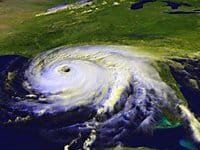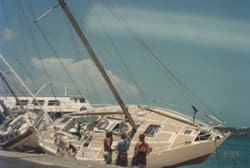 The Hurricane season is upon us again. The season officially started on June 1 and will end on November 30th. In advance of every hurricane season, several forecasts of hurricane activity are issued by national meteorological services, scientific agencies, and noted hurricane experts. According to professor William Gray, the Atlantic basin can expect 18 named storms, 9 hurricanes and 4 major hurricanes, much like 2012. (See historical and future lists of hurricane names here). This is a reminder to all of us in tropical areas not to be complacent!
The Hurricane season is upon us again. The season officially started on June 1 and will end on November 30th. In advance of every hurricane season, several forecasts of hurricane activity are issued by national meteorological services, scientific agencies, and noted hurricane experts. According to professor William Gray, the Atlantic basin can expect 18 named storms, 9 hurricanes and 4 major hurricanes, much like 2012. (See historical and future lists of hurricane names here). This is a reminder to all of us in tropical areas not to be complacent!
We happened to land in the Caribbean in 1996, which was the frontend of an extremely active few years of hurricane activity and we have learned a few valuable lessons in the process! After crossing the Atlantic from the Cape Verde islands off the west coast of Africa, about 18 days at sea, we arrived in the Caribbean on December 26th, 1996 in Antigua where we checked in. The island was still reeling from the aftermath of hurricane Luis but we did not quite understand the scope of he damage until we moved on to S’int Maarten after the New Year. We saw first-hand the devastation a hurricane can inflict.
Hurricane Luis 1996
On September 5th, 1996 a category 4 hurricane called Luis, hit the Caribbean islands with devastating effect, the worst since Donna in 1960. The breathtaking damage caused here by the force of nature was unimaginable. The scene that greeted us as we entered the lagoon in Simpson Bay, is indescribable. The Lagoon was littered with trashed yachts. Of the 1,500 boats sheltered in Simpson Bay Lagoon, nearly 1,300 or 85% were sunken or run aground, tossed aground like toys out of a tub.
 The damage to housing was inestimable. Entire neighborhoods were destroyed, resorts completely blown away and few roofs survived. Thousands of people were homeless and the infrastructure of the island was decimated. The island people are a resilient lot though and they tried their best to clean up and rebuild but tourism was greatly affected and only a few brave tourists started trickling back in. The next year, the Leeward Islands would be struck by Hurricane Bertha, while still repairing from Luis and Marilyn, then successively hit by Hortense, Erika, Georges, José, Lenny and Debby.
The damage to housing was inestimable. Entire neighborhoods were destroyed, resorts completely blown away and few roofs survived. Thousands of people were homeless and the infrastructure of the island was decimated. The island people are a resilient lot though and they tried their best to clean up and rebuild but tourism was greatly affected and only a few brave tourists started trickling back in. The next year, the Leeward Islands would be struck by Hurricane Bertha, while still repairing from Luis and Marilyn, then successively hit by Hortense, Erika, Georges, José, Lenny and Debby.
Hurricane Lenny 1999
On November 18th, 1999 Hurricane Lenny pounded the island with 130mph winds from the WSW as Lenny sat over the island in a weakening mode for 24 hrs before moving on. This time the devastation was more due to flooding than wind. (Read this interesting blow by blow account by Gary E. Brown about Lenny, the eye of the storm). We prepared Royal Salute as best we could, helped anyone who needed help and then rode out the hurricane with friends in their concrete condo on the beach. I have to admit that we were all exhausted, hot and very tense for what was said to be another monster heading our way.
While we were all preparing our vessels, cars and places of business, our friend Lorna, cooked all day in preparation for electricity outages, filled up the bath tubs with water for ablutions, stocked up on ice and once we were all safely at home, she started plying all of us with cocktails. We soon relaxed and watched the hurricane come at us from the balcony before we retired to safety at the height of the storm behind hurricane shutters. We ventured outside when the eye was centered over the island. Everything seemed so calm until one looked up and noticed the rotating clouds in the wall of the hurricane…quite an eerie sight. Royal Salute was in good shape after the storm but the island was not. There were fewer roofs and building damage in general but the flooding was immense.
 What We’ve Learned About Hurricane Preparedness
What We’ve Learned About Hurricane Preparedness
It was a rough few years for the Leewards and we learned a lot being in the “eye of this storm” for several years. Some say that the catastrophic damage to some extent was because of the complacency of the local population as well as the yachting community. After all, they have not had a serious hurricane since 1960. Houses were not constructed to code, the shanty towns sprouted up and down the hills without any regulation and the yachts were poorly prepared, if at all. They squeezed into the lagoon haphazardly without adequate anchors, some still with all their sails on, biminis and loose objects everywhere. The population thankfully learned from this and came out stronger and better and was hurricane hardened veterans, much more prepared for the subsequent hurricanes.
We have been in 10 different hurricanes including Isabel in Annapolis, Maryland and so far have had good luck and came out the other side with no or little damage but as they say, the harder you work, the luckier you get. We definitely did everything in our power to give ourselves the best chance for the best possible outcome. We made our hurricane plan early on in the season and started preparing long before any hurricanes were predicted. We bought enough line, chafe gear, chain, prepared hurricane anchors and found good hurricane holes before the “panic” started. We had peace of mind and knew exactly what to do and where to go.
During that time we had also a charter fleet to deal with in both Sint Maarten and Tortola and had about 30 boats under our care. We did exactly the same preparation as we did for our own boat and we did it early. It is a mountain of work usually in soaring temperatures and when a hurricane veered away form us, there was first a sigh of relief but then the unenviable task loomed of putting it all back together to get the boats charter ready. This could happen two or three times in a season, so it’s not fun and one could easily see how people can become a little lax but we persevered and never lost a single boat.
This discussion is not intended to scare anyone but merely a call to vigilance. Chances are that if you live in the tropical belt, you will encounter a tropical depression, storm or hurricane and the best way to survive it, is to be prepared and not to panic. Be clear about what your plan will be and stick to it. When we first arrived, and decided to stay on Sint Maarten for a while, we talked to the locals, the hurricane veterans, the yachties, and anyone else willing to give advise and we then made our own plan and prepared well in advance, after all Royal Salute was our only home and we needed to protect her at any cost.
Here are our Top Ten Hurricane Tips and check out this neat product called Tideminders.
Get Tideminders here.





